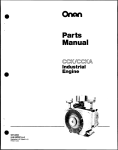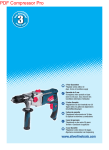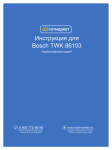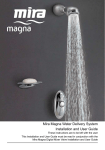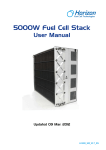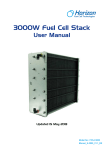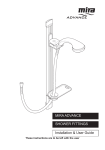Download Schumacher SF-1-12S Owner`s manual
Transcript
OWNER’S MANUAL MANUAL dEL USUARiO GUidE d’UTiLiSATiON Models / Modelos / Modèles: SE-1-12S & SF-1-12S Automatic Battery Charger / Maintainer Cargador de batería automático / Mantener Chargeur de batterie automatique / Avec Mode d’entretien Voltage / Tensión / Tension: 12 Amperage / Amperaje / Ampérage: 1.5 dO NOT RETURN THiS PROdUCT TO THE STORE! Call Customer Service for Assistance: 800-621-5485 ¡NO LO dEVUELVA ESTE PROdUCTO A LA TiENdA! Llame a Servicios al Cliente para Asistencia: 800-621-5485 NE PAS RETOURNER LE PROdUiT AU MAGASiN! Appeler le service clientèle pour l’assistance: 800-621-5485 REAd THE ENTiRE MANUAL BEFORE USiNG THiS PROdUCT. FAiLURE TO dO SO COULd RESULT iN SERiOUS iNJURY OR dEATH. LEA EL MANUAL COMPLETO ANTES dE UTiLiZAR ESTE PROdUCTO. CUALQUiER FALLA POdRÍA RESULTAR EN SERiAS LESiONES O POdRÍA SER MORTAL. LiRE ENTiÈREMENT LE GUidE AVANTd’UTiLiSER CE PROdUiT. L’ÉCHEC dE FAiRE AiNSi PEUT S’ENSUiVRE dANS LA BLESSURE SÉRiEUSE OU LA MORT. 0099000913-03 iMPORTANT: REAd ANd SAVE THiS SAFETY ANd iNSTRUCTiON MANUAL. SAVE THESE iNSTRUCTiONS – This manual will show you how to use your charger safely and effectively. Please read, understand and follow these instructions and precautions carefully, as this manual contains important safety and operating instructions. The safety messages used throughout this manual contain a signal word, a message and an icon. The signal word indicates the level of the hazard in a situation. Indicates an imminently hazardous situation which, if not avoided, will result in death or serious injury to the operator or bystanders. Indicates a potentially hazardous situation which, if not avoided, could result in death or serious injury to the operator or bystanders. Indicates a potentially hazardous situation which, if not avoided, could result in moderate or minor injury to the operator or bystanders. Indicates a potentially hazardous situation which, if not avoided, could result in damage to the equipment or vehicle or property damage. Pursuant to California Proposition 65, this product contains chemicals known to the State of California to cause cancer and birth defects or other reproductive harm. Wash hands after handling. 1. iMPORTANT SAFETY iNSTRUCTiONS – SAVE THESE iNSTRUCTiONS This manual contains important safety and operating instructions. RiSK OF ELECTRiC SHOCK OR FiRE. 1.1 Keep out of reach of children. 1.2 Do not expose the charger to rain or snow. •1• 1.3 Use only recommended attachments. Use of an attachment not recommended or sold by Schumacher® Electric Corporation may result in a risk of ire, electric shock or injury to persons or damage to property. 1.4 To reduce the risk of damage to the electric plug or cord, pull by the plug rather than the cord when disconnecting the charger. 1.5 Use of an improper extension cord could result in a risk of ire and electric shock. Make sure: • That the pins on the plug of the extension cord are the same number, size and shape as those of the plug on the charger. • That the extension cord is properly wired and in good electrical condition. • That the wire size is large enough for the AC ampere rating of the charger as speciied in section 8. 1.6 To reduce the risk of electric shock, unplug the charger from the outlet before attempting any maintenance or cleaning. Simply turning off the controls will not reduce this risk. 1.7 Do not operate the charger with a damaged cord or plug; have the cord or plug replaced immediately by a qualiied service person. (Call customer service at: 1-800-621-5485.) 1.8 Do not operate the charger if it has received a sharp blow, been dropped or otherwise damaged in any way; take it to a qualiied service person. (Call customer service at: 1-800-621-5485.) 1.9 Do not disassemble the charger; take it to a qualiied service person when service or repair is required. Incorrect reassembly may result in a risk of ire or electric shock. (Call customer service at: 1-800-621-5485.) RiSK OF EXPLOSiVE GASES. 1.10 WORKING IN THE VICINITY OF A LEADACID BATTERY IS DANGEROUS. BATTERIES GENERATE EXPLOSIVE GASES DURING NORMAL BATTERY OPERATION. FOR THIS REASON, IT IS OF UTMOST IMPORTANCE THAT YOU FOLLOW THE INSTRUCTIONS EACH TIME YOU USE THE CHARGER. •2• 1.11 To reduce the risk of a battery explosion, follow these instructions and those published by the battery manufacturer and the manufacturer of any equipment you intend to use in the vicinity of the battery. Review the cautionary markings on these products and on the engine. 1.12 This charger employs parts, such as switches and circuit breakers, that tend to produce arcs and sparks. If used in a garage, locate this charger 18 inches (46 cm) or more above loor level. 2. 2.3 2.4 2.5 2.6 2.7 2.8 2.9 PERSONAL PRECAUTiONS RiSK OF EXPLOSiVE GASES. 2.1 NEVER smoke or allow a spark or lame in the vicinity of a battery or engine. 2.2 Remove personal metal items such as rings, bracelets, necklaces and watches when working with a lead-acid battery. A lead-acid battery can produce a short-circuit current high enough to weld a ring or the like to metal, causing a severe burn. Be extra cautious to reduce the risk of dropping a metal tool onto the battery. It might spark or short-circuit the battery or other electrical part that may cause an explosion. Use this charger for charging LEAD-ACID batteries only. It is not intended to supply power to a low voltage electrical system other than in a starter-motor application. Do not use this battery charger for charging dry-cell batteries that are commonly used with home appliances. These batteries may burst and cause injury to persons and damage to property. NEVER charge a frozen battery. NEVER overcharge a battery. Consider having someone close enough by to come to your aid when you work near a lead-acid battery. Have plenty of fresh water and soap nearby in case battery acid contacts your skin, clothing or eyes. Wear complete eye and body protection, including safety goggles and protective clothing. Avoid touching your eyes while working near the battery. •3• 2.10 If battery acid contacts your skin or clothing, immediately wash the area with soap and water. If acid enters your eye, immediately lood the eye with cold running water for at least 10 minutes and get medical attention right away. 2.11 If battery acid is accidentally swallowed, drink milk, the whites of eggs or water. DO NOT induce vomiting. Seek medical attention immediately. 3. 3.2 3.3 3.4 3.5 3.6 3.7 PREPARiNG TO CHARGE RiSK OF CONTACT WiTH BATTERY ACid. BATTERY ACid iS A HiGHLY CORROSiVE SULFURiC ACid. 3.1 If it is necessary to remove the battery from the vehicle to charge it, always remove the grounded terminal irst. Make sure all of the accessories in the vehicle are off to prevent arcing. Be sure the area around the battery is well ventilated while the battery is being charged. Clean the battery terminals before charging the battery. During cleaning, keep airborne corrosion from coming into contact with your eyes, nose and mouth. Use baking soda and water to neutralize the battery acid and help eliminate airborne corrosion. Do not touch your eyes, nose or mouth. Add distilled water to each cell until the battery acid reaches the level speciied by the battery manufacturer. Do not overill. For a battery without removable cell caps, such as valve regulated lead acid batteries (VRLA), carefully follow the manufacturer’s recharging instructions. Read, understand and follow all instructions for the charger, battery, vehicle and any equipment used near the battery and charger. Study all of the battery manufacturer’s speciic precautions while charging and recommended rates of charge. Determine the voltage of the battery by referring to the vehicle owner’s manual and make sure that the output voltage selector switch is set to the correct voltage. If the charger has an adjustable charge rate, charge the battery in the lowest rate irst. Make sure that the charger cable clips make tight connections. •4• 4. 4.2 4.3 4.4 4.5 4.6 5. 5.1 5.2 6. 6.1 CHARGER LOCATiON RiSK OF EXPLOSiON ANd CONTACT WiTH BATTERY ACid. 4.1 Locate the charger as far away from the battery as the DC cables permit. When mounting the charger to the fender well, locate the charger as far away from the battery as the DC cables permit. Never place the charger directly above the battery being charged; gases from the battery will corrode and damage the charger. With the exception of the charger mounting bracket, do not set the battery on top of the charger. Never allow battery acid to drip onto the charger when reading the electrolyte speciic gravity or illing the battery. Do not operate the charger in a closed-in area or restrict the ventilation in any way. dC CONNECTiON PRECAUTiONS Connect and disconnect the DC output ring terminals only after removing the AC plug from the electric outlet. Attach the ring terminals to the battery and chassis, as indicated in sections 6 and 7. FOLLOW THESE STEPS WHEN BATTERY iS iNSTALLEd iN VEHiCLE A SPARK NEAR THE BATTERY MAY CAUSE A BATTERY EXPLOSiON. TO REdUCE THE RiSK OF A SPARK NEAR THE BATTERY: Position the AC and DC cables to reduce the risk of damage by the hood, door and moving or hot engine parts. NOTE: If it is necessary to close the hood during the charging process, ensure that the hood does not touch the metal part of the ring terminals or cut the insulation of the cables. •5• 6.2 6.3 6.4 6.5 6.6 6.7 6.8 Stay clear of fan blades, belts, pulleys and other parts that can cause injury. Check the polarity of the battery posts. The POSITIVE (POS, P, +) battery post usually has a larger diameter than the NEGATIVE (NEG, N, -) post. Determine which post of the battery is grounded (connected) to the chassis. If the negative post is grounded to the chassis (as in most vehicles), see step 6.5. If the positive post is grounded to the chassis, see step 6.6. For a negative-grounded vehicle: You should disconnect both battery cables from the battery before connecting the charger cables. The output leads of the charger are terminated with 3/8" (9.5 mm) dia. ring terminals. Remove the bolt from the battery post connector, insert the bolt through the ring terminal then place the bolt back in the battery connector and tighten. Connect the POSITIVE (RED) ring terminal from the battery charger to the POSITIVE (POS, P, +) ungrounded post of the battery. Connect the NEGATIVE (BLACK) ring terminal to the vehicle chassis or engine block away from the battery. Do not connect the ring terminal to the carburetor, fuel lines, or sheet-metal body parts. Connect to a heavy gauge metal part of the frame or engine block. For positive-grounded vehicle: You should disconnect both battery cables from the battery before connecting the charger cables. The output leads of the charger are terminated with 3/8" (9.5 mm) dia. ring terminals. Remove the bolt from the battery post connector, insert the bolt through the ring terminal then place the bolt back in the battery connector and tighten. Connect the NEGATIVE (BLACK) ring terminals from the battery charger to the NEGATIVE (NEG, N, –) ungrounded post of the battery. Connect the POSITIVE (RED) ring terminals to the vehicle chassis or engine block away from the battery. Do not connect the ring terminals to the carburetor, fuel lines, or sheet-metal body parts. Connect to a heavy gauge metal part of the frame or engine block. Connect the charger AC supply cord to the electrical outlet. When disconnecting the charger, disconnect the AC cord, remove the ring terminal from the vehicle chassis, and then remove the ring terminal from the battery terminal. •6• 6.9 See CALCULATING CHARGE TIME for length of charge information. 7. FOLLOW THESE STEPS WHEN BATTERY iS OUTSidE VEHiCLE A SPARK NEAR THE BATTERY MAY CAUSE A BATTERY EXPLOSiON. TO REdUCE THE RiSK OF A SPARK NEAR THE BATTERY. Check the polarity of the battery posts. The POSITIVE (POS, P, +) battery post usually has a larger diameter than the NEGATIVE (NEG, N, -) post. Attach at least a 24-inch (61 cm) long 6-gauge (AWG) (13 mm2) insulated battery cable to the NEGATIVE (NEG, N, -) battery post. Connect the POSITIVE (RED) charger ring terminal to the POSITIVE (POS, P, +) post of the battery. Position yourself and the free end of the cable you previously attached to the NEGATIVE (NEG, N, -) battery post as far away from the battery as possible – then connect the NEGATIVE (BLACK) charger ring terminal to the free end of the cable using a nut and bolt through both ring terminals. Do not face the battery when making the inal connection. Connect the charger AC supply cord to the electrical outlet. When disconnecting the charger, always do so in the reverse order of the connecting procedure and break the irst connection while as far away from the battery as practical. A marine (boat) battery must be removed and charged on shore. To charge it onboard requires equipment specially designed for marine use. 7.1 7.2 7.3 7.4 7.5 7.6 7.7 7.8 •7• 8. GROUNdiNG ANd AC POWER CORd CONNECTiONS RiSK OF ELECTRiC SHOCK OR FiRE. 8.1 This battery charger is for use on a nominal 120-volt circuit. The plug must be plugged into an outlet that is properly installed and grounded in accordance with all local codes and ordinances. The plug pins must it the receptacle (outlet). Do not use with an ungrounded system. 8.2 Never alter the AC cord or plug provided – if it does not it the outlet, have a proper grounded outlet installed by a qualiied electrician. An improper connection can result in a risk of an electric shock or electrocution. NOTE: Pursuant to Canadian Regulations, use of an adapter plug is not allowed in Canada. Use of an adapter plug in the United States is not recommended and should not be used. Recommended minimum AWG size for extension cord: • 150 feet (45.7 meters) long or less – use an 18 gauge (0.82 mm2) extension cord. 8.3 9. MOUNTiNG iNSTRUCTiONS Mounting the charger to the fender well: The charger can be mounted directly to the fender well of your vehicle as shown. If using the nuts and bolts provided, drill two holes between 3/16" and 1/4" in diameter. (For alignment of holes use the charger as a template.) If the backside of the mounting surface is hard to reach, you may consider using two 1/2" long sheet metal screws (not included) instead of the nuts and bolts provided. Mounting the charger alongside the battery: The charger can also be mounted alongside your vehicle’s battery using the bracket provided. If possible, mount the charger to the side of the battery away from the engine and fan blades. Mount the bracket •8• to the charger as shown using the nuts and bolts provided. Loosen the battery retaining hardware enough that you can insert the bracket between the bottom of the battery and the battery mounting tray as shown. Position the charger so that it will not rub against the battery or any other part of the vehicle, and then tighten the battery retaining hardware. NOTE: Do not drill or puncture the battery. Electrical Installation – The output leads of the charger are terminated with 3/8" dia. ring lugs. Route and secure the AC cord and the output wiring away from the gas line, carburetor or other hot, sharp, moving or pinch parts to avoid damage to the insulation. Secure the AC cord using a cable tie or equivalent. If you have dificulty connecting the output leads, consult your local auto supply store, they may assist you in inding a connecting device for your application. 10. ASSEMBLY iNSTRUCTiONS Remove all cord wraps and uncoil the cables prior to using the battery charger. 11. CONTROL PANEL LEd indicators POWER ON (green) LEd: Indicates the charger is connected to an AC power source and is receiving power. CHARGEd (red) LEd: Indicates the battery is fully charged and the charger is in maintain mode. 12. OPERATiNG iNSTRUCTiONS This battery charger must be properly assembled in accordance with the assembly instructions before it is used. Do not start the vehicle with the charger connected to the 120V AC outlet, or it could result in damage to the charger. Charging 1. Ensure that all of the charger components are in place and in good working condition. 2. Connect the battery following the precautions listed in sections 6 and 7. 3. Connect the AC power following the precautions listed in section 8. •9• 4. The POWER ON (green) LED will light when the AC cord is properly connected. When the battery is charged, the CHARGED (red) LED will light. 5. To disconnect, reverse the procedure. NOTE: This charger is equipped with an auto-start feature. Current will not be supplied to the ring terminals until a battery is properly connected. Meaning, the clips will not spark if touched together. Automatic Charging Mode When an Automatic Charge is performed, the charger switches to the Maintain Mode (see below) automatically after the battery is charged. For a battery with a starting voltage under 1 volt, use a manual charger to pre-charge the battery for ive minutes to get additional voltage into the battery. Completion of Charge Charge completion is indicated by the CHARGED LED. When lit, the charger has switched to the Maintain Mode of operation. Maintain Mode (Float-Mode Monitoring) When the CHARGED LED is lit, the charger has started Maintain Mode. In this mode, the charger keeps the battery fully charged by delivering a small current when necessary. If the battery voltage drops below a preset level, the charger will go back into Charge Mode until the battery voltage returns to the full charge level, at which point the charger will return to Maintain Mode. NOTE: The charger automatically switches between Charge Mode and Maintain Mode as necessary. The CHARGED LED will cycle on when the battery is at full charge and off when the voltage drops below a preset level and the charger goes into Charge Mode. This cycle will continue, and the CHARGED LED will stay on for longer periods of time as the battery becomes more fully charged. NOTE: The maintain mode technology utilized in Schumacher maintainers allows you to safely charge and maintain a healthy battery for extended periods of time. However, problems with the battery, electrical problems in the vehicle, improper connections or other unanticipated conditions could cause excessive current draws. As such, occasionally monitoring your battery and the charging process is recommended. • 10 • 13. MAiNTENANCE iNSTRUCTiONS 13.1 After use and before performing maintenance, unplug and disconnect the battery charger (see sections 6, 7 and 8). 13.2 Use a dry cloth to wipe all battery corrosion and other dirt or oil from the battery terminals, cords, and the charger case. 13.3 Ensure that all of the charger components are in place and in good working condition. 13.4 Servicing does not require opening the unit, as there are no userserviceable parts. 13.5 All other servicing should be performed by qualiied service personnel. 14. MOViNG ANd STORAGE iNSTRUCTiONS 14.1 Store the charger unplugged. The cord will still conduct electricity until it is unplugged from the outlet. 14.2 Store inside, in a cool, dry place. 14.3 Do not store the ring terminals, on or around metal, or clipped to cables. 14.4 If the charger is moved around the shop or transported to another location, take care to avoid/prevent damage to the cords, ring terminals and charger. Failure to do so could result in personal injury or property damage. 15. TROUBLESHOOTiNG PROBLEM POSSiBLE CAUSE Battery ring terminals The charger is do not spark when equipped with an touched together. auto-start feature. It will not supply current to the battery ring terminals until a battery is properly connected. Meaning, the ring terminals will not spark if touched together. • 11 • REASON/SOLUTiON No problem; this is a normal condition. PROBLEM The charger is making an audible clicking sound. Charger makes a loud buzz or hum. POSSiBLE CAUSE REASON/SOLUTiON Battery is defective. Have the battery checked. Shorted battery cables or ring terminals. Circuit breaker cycles when current draw is too high. Check for shorted cables or ring terminals and replace if necessary. Severely discharged battery, but otherwise it is a good battery. The battery may not want to accept a charge due to a run-down state. Allow charging to continue until battery has a chance to recover suficiently to take a charge. If more than 20 minutes, stop charging and have the battery checked. Reverse connections at battery. Shut the charger off and correct the lead connections. Transformer laminations vibrate (buzz). No problem, this is a normal condition. Shorted Diode Assembly or Output Rectiier Assembly (hum). Have charger checked by a qualiied technician. • 12 • PROBLEM POWER ON (green) LED is not lit. Charger will not turn on when properly connected. The battery is connected and the charger is on, but is not charging. POSSiBLE CAUSE REASON/SOLUTiON AC outlet is dead. Check for open fuse or circuit breaker supplying AC outlet. Poor electrical connection. Check power cord and extension cord for loose itting plug. Charger is not plugged in. Plug the charger into an AC outlet. Ring terminals are not making a good connection to the battery. Check for poor connection to battery and frame. Make sure connection points are clean. Connections are reversed. Unplug the charger and reverse the battery connections. Battery is defective (will not accept a charge). Have battery checked. Severely discharged battery, but otherwise it is a good battery. The battery must measure at least 1 volt to start the charging process. If it is under 1 volt, you must charge it using a separate charger to get the voltage up to at least 1 volt before you can use the charger. • 13 •















